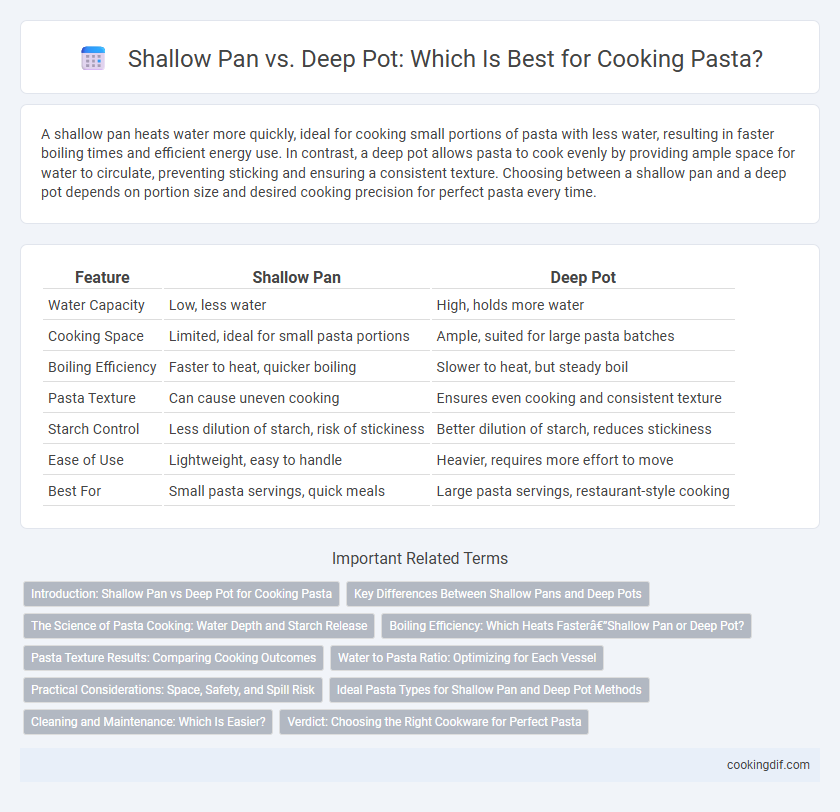A shallow pan heats water more quickly, ideal for cooking small portions of pasta with less water, resulting in faster boiling times and efficient energy use. In contrast, a deep pot allows pasta to cook evenly by providing ample space for water to circulate, preventing sticking and ensuring a consistent texture. Choosing between a shallow pan and a deep pot depends on portion size and desired cooking precision for perfect pasta every time.
Table of Comparison
| Feature | Shallow Pan | Deep Pot |
|---|---|---|
| Water Capacity | Low, less water | High, holds more water |
| Cooking Space | Limited, ideal for small pasta portions | Ample, suited for large pasta batches |
| Boiling Efficiency | Faster to heat, quicker boiling | Slower to heat, but steady boil |
| Pasta Texture | Can cause uneven cooking | Ensures even cooking and consistent texture |
| Starch Control | Less dilution of starch, risk of stickiness | Better dilution of starch, reduces stickiness |
| Ease of Use | Lightweight, easy to handle | Heavier, requires more effort to move |
| Best For | Small pasta servings, quick meals | Large pasta servings, restaurant-style cooking |
Introduction: Shallow Pan vs Deep Pot for Cooking Pasta
A shallow pan allows water to evaporate quickly, requiring careful attention to prevent drying out when cooking pasta. A deep pot offers ample space for water to circulate freely, reducing the risk of sticking and ensuring even cooking. Choosing the right cookware affects pasta texture and cooking efficiency by balancing water volume and heat distribution.
Key Differences Between Shallow Pans and Deep Pots
Shallow pans heat pasta water faster due to a wider surface area, promoting quicker evaporation and reduced cooking time, while deep pots retain heat longer and accommodate larger water volumes, resulting in more consistent temperature control. Deep pots prevent pasta from sticking together by providing ample space for thorough water circulation, whereas shallow pans may cause clumping if overcrowded. Choosing between a shallow pan and deep pot depends on the pasta volume, desired cooking speed, and heat distribution preferences for optimal texture and flavor.
The Science of Pasta Cooking: Water Depth and Starch Release
Using a shallow pan for pasta cooking limits water volume, increasing starch concentration and resulting in creamier, starch-rich sauce due to enhanced starch release during boiling. Deep pots provide ample water, reducing starch concentration and preventing pasta from sticking but yield less sauce thickeness. Optimal water depth balances starch release and pasta texture, influencing both cooking efficiency and sauce consistency in pasta preparation.
Boiling Efficiency: Which Heats Faster—Shallow Pan or Deep Pot?
A shallow pan heats water faster than a deep pot due to its larger surface area exposed to the heat source, allowing quicker boiling times essential for cooking pasta efficiently. The reduced water volume in a shallow pan requires less energy to reach boiling point, accelerating the cooking process. However, deep pots retain heat longer and accommodate larger pasta quantities, making them suitable for bulk cooking despite slower initial heating.
Pasta Texture Results: Comparing Cooking Outcomes
Cooking pasta in a shallow pan results in a firmer texture due to faster evaporation of water and higher heat concentration, which promotes even cooking. In contrast, a deep pot allows pasta to move freely with abundant boiling water, preventing sticking and yielding a softer, more consistent texture. Choosing the right vessel directly impacts the moisture retention and firmness of the pasta, influencing overall dish quality.
Water to Pasta Ratio: Optimizing for Each Vessel
Shallow pans require less water to pasta ratio, typically around 2:1, ensuring pasta cooks evenly without becoming waterlogged. Deep pots need more water, often a 4:1 or higher ratio, allowing pasta to move freely and prevent sticking. Adjusting water volume based on vessel type optimizes texture and prevents undercooked or mushy pasta.
Practical Considerations: Space, Safety, and Spill Risk
A shallow pan offers better control over water evaporation and quicker access to pasta, making it ideal for limited stovetop space and reducing spill risk during stirring. A deep pot holds more water, which helps prevent pasta from sticking but requires more room and careful handling to avoid dangerous boil-overs. Choosing between the two depends on kitchen space constraints, safety preferences, and spill management during the cooking process.
Ideal Pasta Types for Shallow Pan and Deep Pot Methods
Shallow pans are ideal for cooking delicate pasta types like angel hair or thin spaghetti, allowing for quick, even cooking with minimal water that enhances sauce absorption. Deep pots are better suited for thicker, hearty pasta such as penne, rigatoni, or fusilli, providing ample space to prevent sticking and ensure uniform cooking. Using the correct vessel optimizes texture and flavor, depending on pasta shape and cooking method.
Cleaning and Maintenance: Which Is Easier?
Shallow pans typically offer easier cleaning due to their wider, flat surfaces that prevent pasta from sticking and allow quick rinsing. Deep pots can trap food residue in corners and require more thorough scrubbing to remove starch buildup. Stainless steel shallow pans often resist staining better than coated deep pots, reducing maintenance effort over time.
Verdict: Choosing the Right Cookware for Perfect Pasta
Shallow pans offer faster water evaporation and better pasta-to-water contact, ideal for recipes requiring sauce reduction and quick cooking. Deep pots provide ample water volume for evenly cooked pasta, preventing sticking and ensuring consistent texture. Selecting the right cookware depends on pasta type and recipe, with deep pots favored for traditional boiling and shallow pans suited for one-pot pasta dishes.
Shallow pan vs deep pot for cooking pasta Infographic

 cookingdif.com
cookingdif.com